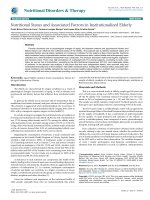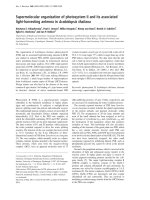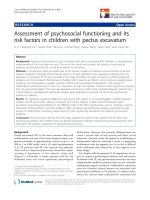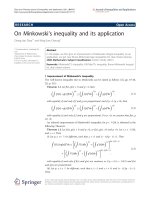MALE PARTNER’S INVOLVEMENT AND ITS ASSOCIATED FACTORS IN PROMOTING SKILLED DELIVERY ATTENDANCE AMONG FATHERS WHO HAVE CHILDREN LESS THAN ONEYEAR OF AGE IN AMBO TOWN, ETHIOPIA, 2017
Bạn đang xem bản rút gọn của tài liệu. Xem và tải ngay bản đầy đủ của tài liệu tại đây (953.5 KB, 62 trang )
ADDIS ABABA UNIVERSITY
COLLEGE OF HEALTH SCIENCES
SCHOOL OF ALLIED HEALTH SCIENCE
DEPARTMENT OF NURSING AND MIDWIFERY
MALE PARTNER’S INVOLVEMENT AND ITS ASSOCIATED FACTORS IN
PROMOTING SKILLED DELIVERY ATTENDANCE AMONG FATHERS WHO HAVE
CHILDREN LESS THAN ONEYEAR OF AGE IN AMBO TOWN, ETHIOPIA, 2017
BY
DANIEL BELEMA (Bsc)
ADVISORS: 1.SR.NADIA WOREDA (Bsc, Msc)
2. BERHANU HORDOFA (Bsc, Msc)
A THESESSUBMITTED TO ADDIS ABABA UNIVERSITY, COLLEGE OF HEALTH
SCIENCE, SCHOOL OF ALLIED
NURSING
AND
MIDWIFERY
HEALTH SCIENCES, DEPARTMENT OF
IN
PARTIAL
FULFILLMENT
OF
THE
REQUIREMENTS FOR MASTER’S DEGREE SPECIALIZED IN MATERNITY AND
REPRODUCTIVE HEALTH.
JUNE 2017
ADDIS ABABA, ETHIOPIA
Acknowledgement
I would like to forward my thanks to Addis Ababa university College of Health Science,
department nursing and midwifery, for giving this chance to attend master‟s program Maternity
and Reproductive Health in Nursing and Ambo University for sponsoring me. Secondly, deepest
gratitude to my advisor Sr.NadiaWorede (Bsc, Msc) and Mr.BirhanuHordofa (Bsc, Msc) for their
continuous support, patience, motivation, enthusiasm, and immense knowledge. Their guidance
helped me throughout the time of writing this proposal and theses.
I would also like thank my fellow class mate of Addis Ababa University College of Health
Sciences, School of Allied Health Science department of nursing and midwifery for the sharing
their comments and working together before deadlines.
My thanks also goes to all my friends and families who provided me with their continuous
support and help me finish this proposal.
II
TABLES OF CONTENTS
PAGES
Acknowledgement .................................................................................................................... II
List of Figures .......................................................................................................................... V
List of Tables .......................................................................................................................... VI
Acronyms and Abbreviation .................................................................................................. VII
ABSTRACT ......................................................................................................................... VIII
1. INTRODUCTION ................................................................................................................ 1
1.2. STATEMENT OF THE PROBLEM ................................................................................. 3
1.3. SIGNIFICANCE OF THE STUDY................................................................................... 5
2. LITERATURE REVIEWS ................................................................................................... 6
2.2. Male involvement in the choice of birth place..................................................................... 6
2.3. Factors Associated With Male Involvement in Promoting Skilled Delivery Attendance of
Spouse ......................................................................................................................................... 7
2.3.1 Socio-Demographic factors ............................................................................................... 7
2.3. 2.Economic Factors.............................................................................................................. 8
2.3.3. Health Service Related Factors ....................................................................................... 9
2.3. 4.Socio-Cultural factors ....................................................................................................... 9
2.3.5. Knowledge and perception related factors ...................................................................... 10
2.4. CONCEPTUAL FRAME WORK ..................................................................................... 12
3. STUDY OBJECTIVES ....................................................................................................... 13
3.1. General objective ............................................................................................................... 13
3.2. Specific objective ............................................................................................................... 13
4. METHODOLOGY ............................................................................................................. 14
4.1. Study area........................................................................................................................... 14
4.2. Study design and period ..................................................................................................... 14
4.3. Source population .............................................................................................................. 14
4.4. Study population ................................................................................................................ 14
4.5. Inclusion and Exclusion criteria......................................................................................... 14
4.5.1 .Inclusion criteria ............................................................................................................. 14
4.5.2. Exclusion criteria ............................................................................................................ 14
4.6. Sample size determination ................................................................................................. 15
III
4.7. Sampling procedures .......................................................................................................... 16
4.8. VARIABLES OF THE STUDY ...................................................................................... 17
4.8.1. Dependant variable ......................................................................................................... 17
4.8.2. Independent variable ....................................................................................................... 17
4.9. Operational Definitions ...................................................................................................... 17
4.10. Data collection tool .......................................................................................................... 18
4.11. Data collection methods ................................................................................................... 18
4.12. Data quality control/assurance ......................................................................................... 19
4.13. Data Analysis procedures ................................................................................................ 19
4.14. Ethical clearance .............................................................................................................. 20
4.15. Dissemination and Utilization of results .......................................................................... 20
5. RESULTS ........................................................................................................................... 21
5.1. Socio-demographic Characteristics of Male Partners ........................................................ 21
5.6. Level of male partners‟ involvement in promoting skilled delivery attendants .............. 28
5.7. Bivariate and multivariate logistic regression analysis of male involvement and its
explanatory variables .............................................................................................................. 30
6. Discussion ........................................................................................................................... 32
7: Limitations and strength of the Study ................................................................................. 34
7.2. Strength ............................................................................................................................ 34
8. Conclusion and recommendation ........................................................................................ 35
9. Reference ........................................................................................................................... 37
10. Annex ................................................................................................................................ 39
Annex I: Information Sheet and Consent Form: (English Version) ......................................... 39
Annex II.English version questionnaires for interview ............................................................ 41
Annex II. Afan Oromo version of questionnaires ..................................................................... 48
IV
List of Figures
Figure 1: Conceptual frame work of male involvement in promoting skilled delivery attendance
of spouse developed from reviewed literatures……………………………………..12
Figure 2:- Diagrammatic representation of sampling procedures…………………….16
Figure3. Level of male partners‟ knowledge in choice of delivery site and its benefits in Ambo
city administration, Oromia regional state, May 2017………….……………………..26
Figure4.Level of male partner‟s perception on delivery complication and benefits of being
attended by skilled attendants………………………………………………………27
Figure5.Level of male partner‟s involvement in promoting skilled birth attendant in Ambo city
administration, Oromia regional state, May 2017………………………………….29
V
List of Tables
Table.1 Socio-demographic characteristics of male partner‟s involvement in promoting skilled birth
attendant in Ambo city administration, Oromia regional state, May 2017 ………………………21
Table2.Influence of Healthcare facilities of male partner‟s involvement in promoting skilled birth
attendant in Ambo city administration, Oromia, regional state, May 2017 …………………….23
Table.3. socio-cultural barriers of male partners in Ambo city administration, Oromia, regional state,
May 2017………………………………………………………………………….24
Table4.Knowledgeof male partners toward skilled delivery attendants in Ambo city administration,
Oromia, regional state, May 2017……………………………………………………………25
Table.5.distribution of level male partners‟ involvement in choice of delivery site Ambo city
administration, Oromia regional state, May 2017………………………………………………28
Table.6.Bivariate and multivariate logistic regression analysis of male involvement in promoting
skilled birth attendant………………………………………………………31
VI
Acronyms and Abbreviation
AMRF
African Medical and Research Foundation
ANC
Antenatal Care
DHS
Demographic and Health Survey
EDHS
Ethiopia Demographic Health Survey
HIV
Human Immune Deficiency Virus
ICPD
International Conference on Population and Development
MDGS
Millennium Development Goals
MMR
Maternal Mortality ratio
MM
Maternal Mortality
SBA
Skilled Birth Attendant
SSA
Sub-Saharan Africa
SPSS
Statistical Package for Social Science
WHO
World Health Organization
VII
ABSTRACT
Background: Male partner‟s involvement in maternal health care has been described as a
process of social and behavioral change that is needed for men to play in maternal health care
with the purpose of ensuring women‟s and children`s wellbeing. How every little has been
explored about level of male involvement and associated factors in promoting skilled birth
attendant in the study area
Objective: To assess male partner‟s involvement and its associated factors in promoting skilled
delivery attendance among fathers who have children less than one year of age in ambo town
west shoa zone, western Ethiopia, 2017
Methods: Community based cross sectional study design was conducted on a sample of 408
male partners‟ that has children less than one year of age. The data was collected using simple
random sampling method. The data were entered into Epi 3.3.5 version data and analyzed by
SPSS window software.Discriptive statistics and measure of central tendency and variability
were computed. Binary and multiple logistic regressions were used to identify the association
between dependent and independent variables.
Result. Out Of three hundred ninety six study Participants‟, One hundred sixty-six (41.9 %) of
male partners involved in promoting skilled birth attendant of their spouse. Age group between
20-29 years [AOR=16.34(7.582-35.238)], participant who have diploma and above
[AOR=2.85(1.013-8.057)], those who are civil servant [AOR=2.51(1.449-4.351)], monthly
income who have greater than three thousand and five hundred [AOR=2.25(CI: 1.084-4.707)]
and knowledge of skilled attendant [A0R=2.73(1.617-4.636)] had significant association with
male involvement
Conclusion and recommendation: level of male partner‟s involvement in promoting skilled
birth attendant was low. Age of male partners, educational level, occupational status, monthly
income and knowledge on skilled birth attendant were found to be associated with male partner‟s
involvement. To improve male partner involvement, policy makers and different stake holders
has to adopt strategies/programs to promote male involvement, promote education and facilitate
economic empowerment, create awareness on importance of male involvement in skilled birth
attendant through media ,health education and community mobilization
Key words: Male involvement, skilled delivery attendant, Ambo town, Ethiopia
VIII
1. INTRODUCTION
Pregnancy &child birth is natural & often an eventful process. Many women are at risk for
developing complication at any time during this period(1) .A vast majority of maternal deaths are
due to preventable direct obstetric causes such as hemorrhage, infection, obstructed labor, unsafe
abortion and high blood pressure (2)These causes can be detected and managed early during
antenatal care (ANC) and intrapartum period by existing and well known medical interventions
Complication of pregnancy &child birth are known to be the leading cause of disability &death
among woman of reproductive age (15-49years), especially in developing countries(1)
Delay to make a decision to seek care is considered as one of the contributing factors that is
attributed to maternal morbidity and mortality and is preventable (3). Hence, access to skilled care
before, during and after childbirth is among the key strategies to reduce maternal mortality (MM)
and improve the health of women (4)
A Prompt decision in seeking reproductive health service like having a skilled birth attendant
(SBA) at every delivery has been found to be markedly influenced by husbands ((5-8).Husbands
typically serve as gatekeepers of women's reproductive health including decisions about where they
will deliver (6, 9, 10)
In sub-Saharan countries, men generally are considered to be the decision makers regarding the
location at which their spouse should give birth(9-11).Therefore, male involvement in maternal
health care services serves as a building block for ensuring women‟s and children`s wellbeing.
The 1994 International Conference on Population and Development (ICPD), held in Cairo,
recommended males to be involved in the reproductive health of their wives or partners. It also
encouraged reproductive health care programmers to adopt a more holistic approach that includes
men and focuses on couples rather than focusing on the women alone. in addition, male‟s
involvement in maternal health is now being advocated as an essential element of world Health
organization (WHO) initiative for making pregnancy safer(12)
1
Male partners
involvement in maternal health care has been described as the participation
,commitment and joint responsibility of men with woman and behavioral change that is needed for
men to play in maternal health care with the purpose of ensuring women‟s and children`s
wellbeing(12)
Male involvement increases outreach as well as utilization of the various reproductive health
services. Interventions that include men during pregnancy and childbirth have shown to yield
positive health benefits to women and their children (13) .Therefore one of the best ways to reduce
maternal mortality and improve women‟s health is by improving male partner‟s involvement in
promoting skilled delivery attendance of their spouse which can be done by assessing their level of
involvement and factors affecting it in the study area.
2
1.2. STATEMENT OF THE PROBLEM
Maternal mortality (MM) is a key indicator of international development, and its reduction has long
been and continues to be a global challenge, particularly in low-income countries. In 2015, an
estimated 303,000 women died as a result of pregnancy and childbirth-related complication
(14)Developing countries accounted for about 99% of global maternal deaths, with the maternal
mortality ratio (MMR) of239 per 100,000 live births, 14 times higher compared to the developed
regions (17 maternal deaths per 100,000 live births)(14).Despite an apparent global improvement
made over the last two and half decades, the worldwide MM dropped by about 45% in 2015(1416)which is far from the decline targeted (75%) to be achieved by 2015.
Sub-Saharan Africa (SSA) alone accounted for 66% of maternal deaths with the MMR of 546 per
100,000 live births (14).In Ethiopia, maternal mortality ratio is estimated at 412/100,000 live births
according to EDHS 2016(17), indicating a significant improvement from that reported in 2011
EDHS However, this figure is far from the millennium development goal (MDG) target of
267maternal deaths per 100,000 live births by 2015. (14)
Lack of maternal health services has been considered as one of the factors that resulted in the slow
progress of maternal mortality reduction programs (18). However, in some cases where the different
services exist, husbands were reported to forbid their wives from seeking any maternal health care
like delivery.
Globally, the proportion of deliveries attended by skilled health personnel increased from 59 % in
1990 to 71 % in 2014(19). Yet this leaves more than one in four babies and their mothers without
access to crucial medical care during childbirth. In Sub-Saharan Africa (SSA), 42% of child birth
are assisted by skilled birth attendants while in Ethiopia, it accounts for only 28 %.(14, 17)
Studies conducted in different countries indicate that social, cultural, and religious factors play a
paramount role in SBA (skilled birth attendant) service uptake. Gender inequality, harmful
traditional practices, the low social status of women, limited female involvement in decision
making, family members‟ influence and decisions, and women‟s limited influence over their
families are key factors in SBA service uptake(20). In addition, religious reasons, poor attitude of
health workers, and the poor quality of care are related to low service uptake (21)
3
Studies conducted in lemmo and meraka woreda, southern Ethiopia showed that male involvements
on skilled delivery care was only41.3%and 38.2 respectively (22, 23)Reporting findings of their
studies conclude that efforts should be made to improve awareness of the male partner‟s on
institutional delivery through community-based health education and through community leaders in
reaching out to men and encouraging their involvement on skilled delivery care services
Even though studies have been conducted in Ethiopia concerning male partner involvement in
promoting skilled delivery attendance of their spouse, focus has always been on district or rural area
while the prevalence and associated factors of male involvement in urban area gained little
attention. Therefore, this study aims at assessing male involvement in promoting skilled delivery
attendance and its associated factors in ambo town which could serve as baseline information for
creating an intervention in this study area.
4
1.3. SIGNIFICANCE OF THE STUDY
Because it addresses the issues related to maternal morbidity and mortality. The present study will
be important for different stakeholders of our society.
The result of study will help as input for Ambo town health bureau to develop strategies and
guidelines or standards for scaling up male involvement in promoting skilled delivery care of their
spouse.
This study will provide information about the issue to be emphasized by health care workers to
improve the quality of service which would attract male partner‟s in order to utilize the service.
The information derived from this study would provide directions for both governmental and nongovernmental bodies to implementing successful strategies that are effective in promoting male
involvement in maternal health service utilization which eventually leads to improvement in health
service coverage and heath of the women.
In addition, the findings from this study would benefit researchers interested in the field by
providing base line information regarding male involvement in promoting skilled attendant in the
study area
5
2. LITERATURE REVIEWS
2.2. Male involvement in the choice of birth place
Studies in many settings showed that the support of male partners influences women‟s uptake of
maternal health services, their workload, nutrition and wellbeing during pregnancy, and the ways
they care for and feed their babies. So there are many potential benefits to reaching expectant
fathers with information and services(24).According to literature the level of male involvement in
maternal health specifically in promoting skilled delivery attendance of spouse is found to be
different for different countries as well as study participants
A Community-based crosses sectional study, conducted in Japan among 426 husbands showed that,
69.7% were found to be involved in decision-making about the place of delivery. Regarding birth
preparedness, the majority of husbands prepared for skilled birth attendance (91.1%), and81.7%
saving money before their spouses gave birth (25). In addition, a nationally representative survey
which was conducted in Kenya among 730 males expressed that male involvement in maternal
health determined the utilization of skilled birth attendants among their wives. This study revealed
that majority (68 %) of women whose husbands accompanied them for at least one ANC visit
utilized a skilled birth attendant during delivery (26)
In 2011 a cross sectional study was carried out in Jinja district eastern Uganda by Peter Dyogo to
assess males‟ involvement in maternal health care services among 469 males. This study showed
that showed that about, 43% accompanied their partners during delivery and 32.5% of the men
reported joint couple decision-making with the wife on where to attend delivery (27)
Furthermore, a Community based cross-sectional study
conducted among 676 Husbands
inmarekaworeda, Southern Ethiopia revealed that male partners involvement in promoting
institutional delivery was 41.3% and only 32.7% of husbands‟ planned health facility for delivery,
52.4% made joint decision for skilled delivery care and 43.2% made prior arrangement for
delivery(23)
6
Male involvement in maternal health was also assessed in lemmo woreda; Southern Ethiopia by a
community based cross- sectional study among 335 male partners showed that male partner‟s
involvement in promoting institutional delivery was 38.2%.Only 15.5% were involved in discussing
the issue with their relatives, 20%discussed with their friends, 44.2%accompanied their spouse for
ANC follow-up and40.9% decided to deliver in health institution for current child (22)
2.3. Factors Associated With Male Involvement in Promoting Skilled Delivery Attendance of
Spouse
2.3.1 Socio-Demographic factors
An educational level and type, as a socio demographic factor could have an impact on male
involvement in maternal health.
A study conducted in northern Nigeria showed that Men who had formal education (n=103, 37.9%)
were found to be more likely to participate in maternity care compared to those with non-formal
education (11)
Another study conducted in Eastern Uganda. Findings from this study revealed that men who had
complete 8 or more years of education were twice more often involved compared with those with
less than 8years of education (p
sought skilled care at delivery than the spouses of less educated male partner(p=0.000)(29)
Furthermore, another study conducted in Munisa woreda; South-East Ethiopia concluded that
husband´s educational levels are connected to the decision about delivery place, higher levels being
contributing to institutional delivery (30)on the contrary a study conducted in lemmo woreda,
Ethiopia showed that no relationship exist between male involvement and level of education (22)
Age of the women and male partners was also found to significantly affect male partner
involvement in multiple literatures.
A study conducted in northern Nigeria found that Young paternal age is associated with maternal
care involvement (AOR =1.5, 95% CI=1.2-2.6) (11). Similarly younger men were involved two
times more likely on skilled delivery care than older ones in mareka district, Ethiopia (AOR=1.77
7
95% CI1.19-2.62)(23).On the contrary study in Busia Kenya, established no statistical difference
between the age of a male partner and type of delivery of spouse (skilled or unskilled) (29)
Reviewed literatures have also indicated marital status as one of the factors that significantly affect
male partner involvement.
According to study which was conducted in northern Nigeria men in monogamous marriages
accompanied their spouses for maternity care compared to (n=24, 15.3%) their polygamous
counterparts (χ2=3.6, P<0.001)(11). on contrary Study conducted
polygamous marriage had a negative association with
in Japan showed that
delivery care accompaniment (AOR 0.34,
95% CI 0.12–0.96, p < 0.05) (25)
2.3. 2.Economic Factors
Another factor that affects Male involvement in maternal health of their partners was found to be
monthly income and job status.
A Study conducted in Kathmandu, Nepal revealed that male partners whose monthly income of
NPR 500 or above per month were found to be two times involve in skilled birth preparedness as
compared to monthly income less than NPR 500 (p<0.001)(31)
Another study conducted in lemmo woreda southern Ethiopia showed that male partners who had
monthly income between 490-800 birr were 71% (AOR: 0.29, 95% CI: 0.116, 0.719) less likely to
promote their spouses to attend institutional delivery when compared to those with monthly income
above 800 birr(22)
Type of job was also found to be among the factors affecting male involvement. A study conducted
in eastern Uganda showed that Taxi drivers and boda boda riders were found to be less involved in
the MCH services due to the nature of their jobs as compared to their counterparts such as farmers
(OR =0.3; 95% CI: 0.1-0.9; p≤ 0.05)(28). on the contrary study in Kenya Busia showed that
spouses of male partners with formal employment or engaged in a business were more likely to
seek skilled delivery than those whose partners were unemployed (.OR 0.455 95% CI 0.286-0.720,
p=0.001(29)
8
2.3.3. Health Service Related Factors
A study conducted in Eastern Uganda established that the harsh language (like you can die) used by
the health workers was a barrier to male participation. Further, some of the health workers did not
allow men to access the ANC settings and as such discouraged men from accompanying their
spouses to delivery service(28)
According to study conducted in Busia Kenya majority of the study participant (61.1%) state that
high fees charged for deliveries at health facilities and found to be major contributing factors to low
male lessen the level of male involvement in child birth activities (29)
Similarly, a study conducted in Lemmo woreda Ethiopia reported that male partners who
considered the health service fees to be affordable were two times more likely to participate in
promoting institutional delivery as compared to those who said cost of health services are not
affordable (22)
A study conducted in Matayos Sub-County, Busia, Kenya showed that majority of respondent
(96%) agreed
that there was health facility in the area and distance to the nearest was 1-
2killometeres but accessibility hindered male partners to participate in skilled delivery attendance
(32)
2.3. 4.Socio-Cultural factors
Cultural beliefs are known to play role in determining the involvement of males in maternity care
especially in skilled delivery of their spouse.
A Study conducted in Kenya Busia showed that many cultural beliefs exist among the male partner
that affect their involvement in supporting their spouses to access skilled delivery services. For
instance, out of 380 male partners participants 33%stated that their newly born babies must be kept
indoors for three days for boys and two days for girls and taken out only after the naming ceremony
and 45% of them said that child-birth is a woman‟s affair which does not require their males
participation.(29)
9
A study in Bangladesh also showed that certain socio-cultural factors affect male involvement in
promoting skilled delivery of spouse. These includes feeling shy, embarrassed, feeling out of place
and most men believe that it is inappropriate place are common barriers for male involvement in
skilled delivery attendant (7)
Besides cultural beliefs, religion was also found to be among the factors that affect male
involvement to participate in skilled delivery attendance of their spouses in few countries
A study conducted in northern Nigeria showed that higher proportion (n=18, 51.4%) of non-Muslim
men participated in maternity care compared to their Muslim counterparts (n=107, 30.2%)
(χ2=6.6)(11)
2.3.5. Knowledge and perception related factors
A study conducted in India showed that men´s knowledge about pregnancy related care increases its
utilization and suggested that men´s presence during antenatal visits might increase the likelihood
of institutional delivery (33)
Another study Conducted in Busia Kenya reported that low knowledge regarding complications
associated with pregnancy and delivery has been identified as determinant for male partner
involvement in promoting skilled birth attendant. According to this study majority of male partners
exhibited very low knowledge regarding complications that are associated with pregnancy and
delivery, with 24.9% of them responding that they did not know a single complication and those
who were able to mention at least one complication were very few (29)
In a study in Tanzania, poor understanding among men of the health problems faced by mothers
and babies, lack of knowledge regarding how to take an active role in maternal and child health
have been identified as barriers to male involvement in choice of delivery site (34)
In 2014a cross sectional study was carried out in lemmo woreda, Ethiopia by Okatiso to assess male
partners‟ involvement in promoting skilled delivery attendance of a spouse and associated factors
among 335 males. This study showed that showed that three fourth (74.6%) of the respondents were
found to have good knowledge about institutional delivery, while a substantial proportion (25.4%)
10
of the respondents were not. The finding of this study showed Majority (80.6%) reported that they
had known about ANC follow up of their spouses. When asked about why it is important to take
their wives to health facility for delivery? 59.1% said to avoid delay in getting medical care in case
of emergency, 62.1% said to get access to skilled care, and 64.5% said to get immediate treatment
for mother and new born. While 2.4% of them said they did not know why institutional delivery is
important (22)
A Study conducted in peri-urban Gulu district, Northern Uganda showed that male who perceived
fetal monitoring in health facility is important were two times more likely to participate on skilled
care than who perceive it has no important (PRR 1.20; 95%CI 1.03, 1.40; p = 0.018)(35)).Similarly
in meraka district, Ethiopia showed that male who perceived delivery in health facility is important
for mother and new born were two times more likely to participate on skilled care than those who
perceived it has no importance(AOR 1.68, 95% CI: 1.13-2.50)(36)
11
Conceptual frame work
2.4. CONCEPTUAL FRAME WORK
Economical status
Socio demographic
-occupation
-Age
-Income
-Marital status
-Educational status
- Socio-Cultural
→→
Male partner’s
involvement in promoting
skilled birth attendant
-Knowledge
-perception
-Cultural beliefs
- Religion
→
Health services
-Availability
-Affordability of cost
-Quality of health care
Figure 1: Conceptual frame work of male involvement in promoting skilled delivery attendance
of spouse developed from reviewed literatures (26-39)
12
3. STUDY OBJECTIVES
3.1. General objective
To assess male partner‟s involvement and its associated factors in promoting skilled delivery
attendance among fathers who have children less than one year of age in Ambo town, west shoa
zone Ethiopia, 2017
3.2. Specific objective
To determine the level of males involvement in promoting skilled delivery attendance of
their spouse
To determine factors that are associated with male partner‟s involvement in promoting
skilled delivery care utilization of their spouse.
13
4. METHODOLOGY
4.1. Study area
This study was conducted in Ambo town West shoa Zone which is located at 115 kilometers to
west Addis Ababa, the capital city of Ethiopia. This town has 6 kebeles and according to Health
Bureau of Ambo city Administration total numbers of households who have children less than one
year of age was 2566. The total population this town is estimated to be 80712. Out of this total
estimated proportion, male accounts for 50.03 %( 39553) while female accounts for 49.97%
(39506).
4.2. Study design and period
A community based cross sectional study design was employed to collect data from the study
participants from March to April 2017
4.3. Source population
All male partners who have children in Ambo town, during study period.
4.4. Study population
All eligible male partners having children less than one year of age who are randomly selected from
the different kebeles of ambo town during the data collection period.
4.5. Inclusion and Exclusion criteria
4.5.1 .Inclusion criteria
Male partner‟s who are 18yeas and above and had at least one child in the last one year
male partner‟s who are willing to give consent to partake in the study
4.5.2. Exclusion criteria
Those Participants who doesn‟t permanently reside in the study area
Participants with mental and other illnesses who are unable to communicate
14
4.6. Sample size determination
The sample size required for this study was calculated based on a single population proportions
formula as follows.
n= (Z a/2)2p (1-P)
d2
n= ((1.96)20.41 (0.59)) / (0.05)2
n= 371
By considering non -response rate of 10 % the final sample size will be 408
Where: n is sample size, Z is standard normal distribution corresponding to significance level at α
= 0.05, d is margin of error assumed to be 5% , P is Prevalence of male partner‟s involvement in
promoting skilled delivery attendant= 41 %( taken from a study done at Mareka woreda, Southern
Ethiopia 2014)(23)
15
4.7. Sampling procedures
All 6 kebeles found in ambo town, will be included and the calculated sample size was allocated
proportionally to each kebeles as shown in the diagram below. A list of household that fulfills the
inclusion criteria i.e. (households with fathers that have a child less than one year of age) was
provided by the health extension workers. Using this list simple random sampling was used to
target the study units.
Diagrammatic representation of sampling procedure
01- Kebele 02-kebeke
406
440
03-kebele
04-kebele
560
300
05-kebele
06-kebele
370
490
58
78
PROPORTIONAL ALLOCATION
65
70
89
48
SRS
408
Figure 2:- Diagrammatic representation of sampling procedures
16
4.8. VARIABLES OF THE STUDY
4.8.1. Dependant variable
Male partner‟s involvement
4.8.2. Independent variable
Socio-demographic variables :- age, marital status, education, ethnicity, religion
Economic status
Health service related factors:- affordability &accessibility of services
Knowledge
perception
4.9. Operational Definitions
Male involvement is measured by considering different components .These includes discussion
with health professionals on the place of spouses‟ delivery, encouraging spouse for institutional
delivery, accompanying spouse for ANC, birth preparedness, and discussion with relatives and
friends.
Involved. Those participant who had involved equal to three or more components (37, 38)
Not involved .Those participant that had involved in less than three of the components
Knowledge of male partner’s involvement decision in place of delivery: -Eleven knowledge
related items were used to assess male partners and mean was considered to differentiate between
participants with good and poor knowledge.
Good knowledge. Those participants who score more than the mean value
poor knowledge .Those participant who score less than mean value
17









